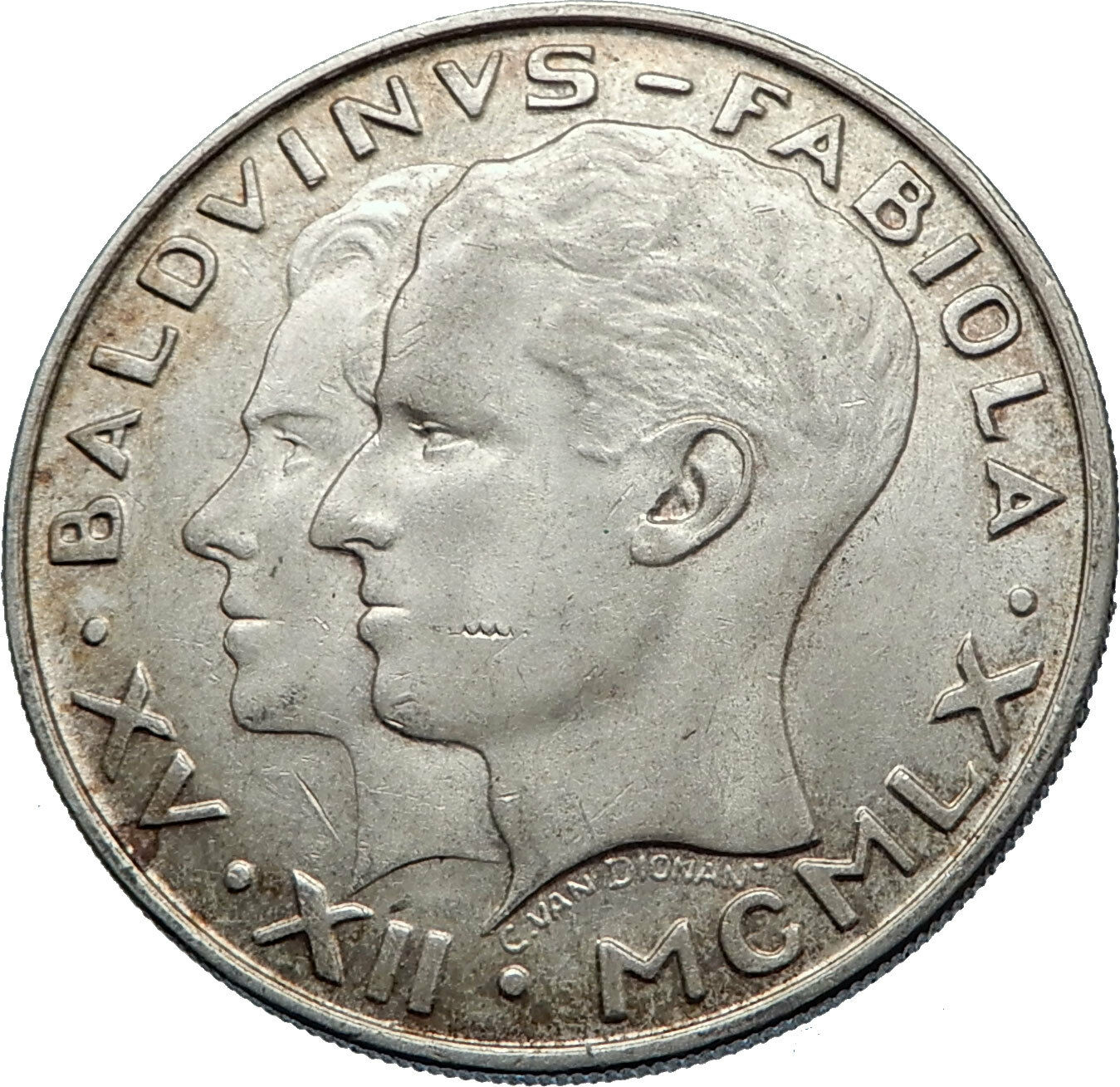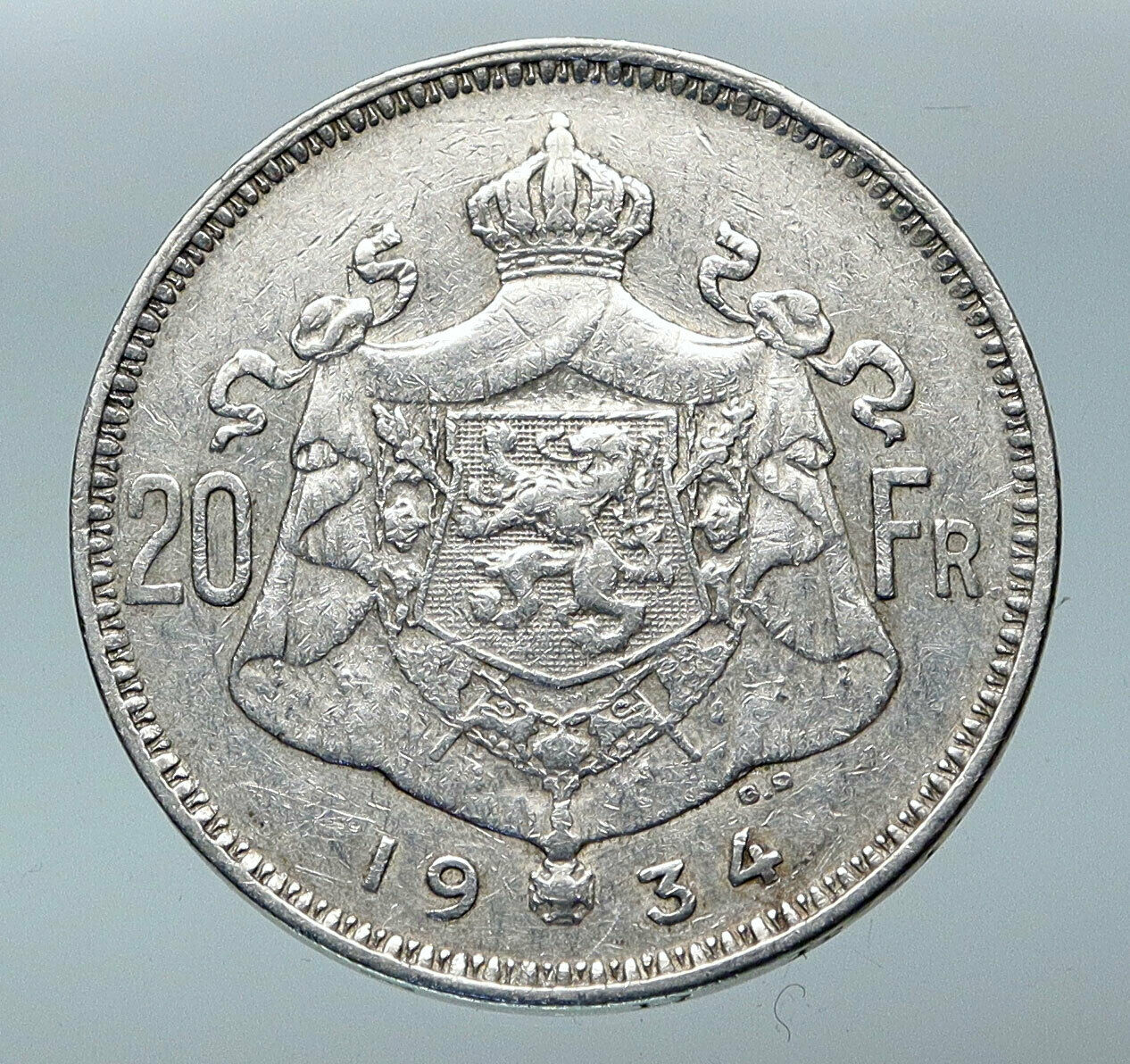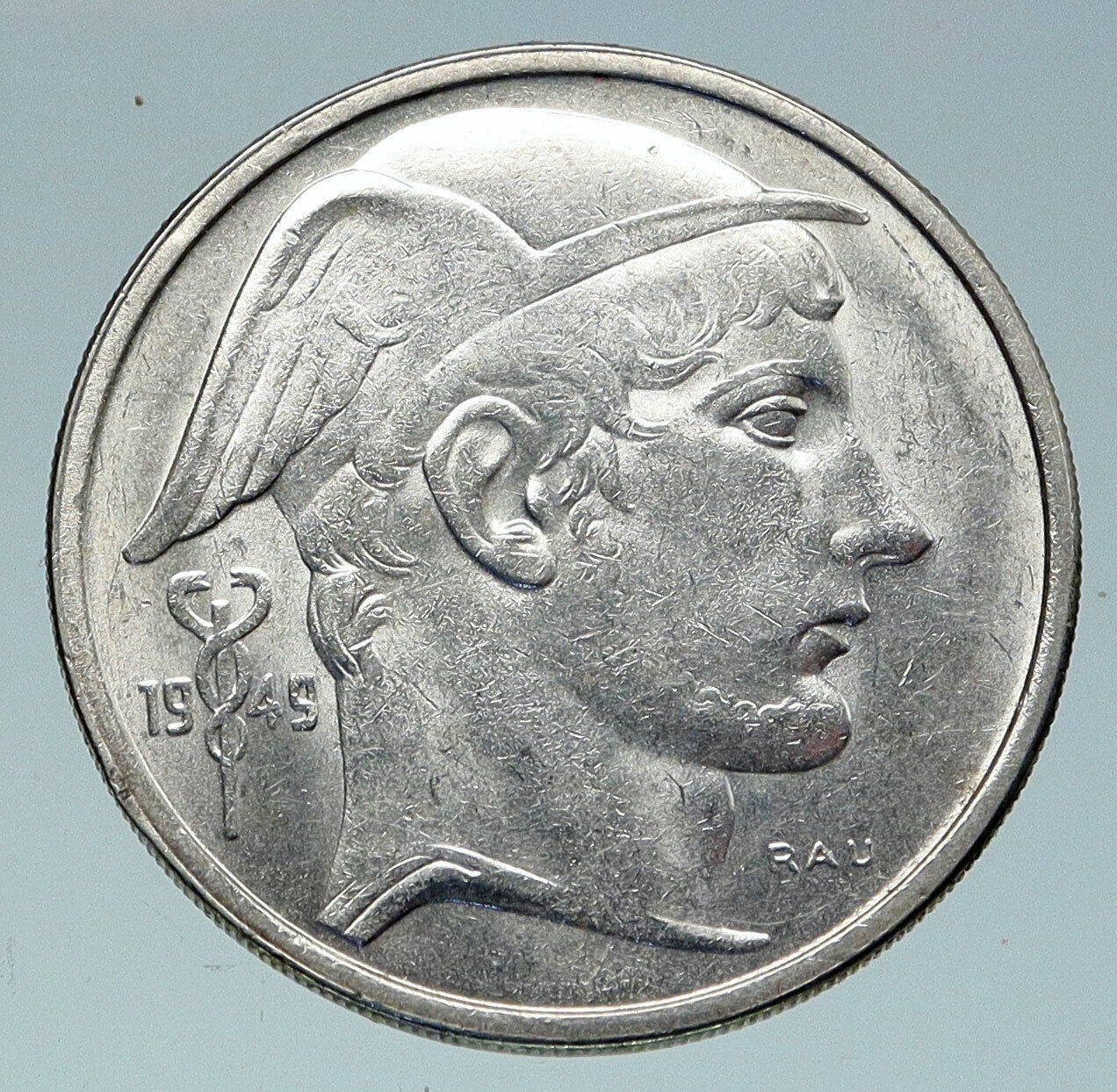|
Belgium under Leopold III – King: 17 February 1934 – 16 July 1951
Brussels Exposition and Railway Centennial
1935 Silver 50 Francs (50 Frank) 35mm (21.98 grams) 0.680 Silver (0.4810 oz. ASW)
Reference: KM# 106, Mor# 442, LA# BFM-181
CENTENAIRE DES CHEMINS DE FER BELGES 1835 – 1935, Building of Brussels Expo.
ROYAUME DE BELGIQUE EXPOSITION DE BRUXELLES 50 FR, Standing winged Saint Michiel standing on top of a dragon.
Edge Lettering:
SOUS LE REGNE DU ROI LEOPOLD III
You are bidding on the exact item pictured, provided with a Certificate of Authenticity and Lifetime Guarantee of Authenticity.
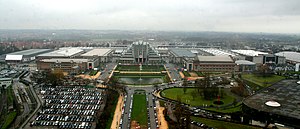 The Brussels International Exposition of 1935 (French: Exposition Universelle et Internationale Bruxelles de 1935) was a World’s fair held between 27 April and 6 November 1935 on the Heysel Plateau in Brussels (Belgium). The Brussels International Exposition of 1935 (French: Exposition Universelle et Internationale Bruxelles de 1935) was a World’s fair held between 27 April and 6 November 1935 on the Heysel Plateau in Brussels (Belgium).
Officially sanctioned by the Bureau International des Expositions, twenty-five countries officially participated and a further five were unofficially represented. The theme was colonisation, on the 50th anniversary of the establishment of the Congo Free State.
The exhibition attracted some twenty million visitors. Belgian architect Joseph van Neck was the principal architect of the fair and of the Art Deco Palais des Expositions (also known as the Grand Palais), with its interior concrete parabolic arches, and four heroic bronze statues on piers.
Among many other contributors, Le Corbusier designed part of the French exhibit; the Belgian modernist architect Victor Bourgeois designed the Grand Palais, the Leopold II restaurant and the Soprocol pavilion. The Belgian art exposition prominently displayed the work of contemporary Belgian artists, including Paul Delvaux, René Magritte and Louis Van Lint, boosting their careers.
The Palais des Expositions, and at least three other of the 1935 structures, were re-used for the 1958 Brussels World’s Fair (Expo 58) which was held at the same site in 1958.
.jpg/220px-Leopold_III_van_België_(1934).jpg) Leopold III (3 November 1901 – 25 September 1983) reigned as the fourth King of the Belgians from 1934 until 1951, when he abdicated in favour of the heir apparent, his son Baudouin. From 1944 until 1950, Leopold’s brother, Charles, served as prince regent while Leopold was declared unable to reign. Leopold’s controversial actions during the Second World War resulted in a political crisis known as the Royal Question. In 1950, the debate about whether Leopold could resume his royal functions escalated. Following a referendum, Leopold was allowed to return from exile to Belgium, but the continuing political instability pressured him to abdicate in 1951. Leopold III (3 November 1901 – 25 September 1983) reigned as the fourth King of the Belgians from 1934 until 1951, when he abdicated in favour of the heir apparent, his son Baudouin. From 1944 until 1950, Leopold’s brother, Charles, served as prince regent while Leopold was declared unable to reign. Leopold’s controversial actions during the Second World War resulted in a political crisis known as the Royal Question. In 1950, the debate about whether Leopold could resume his royal functions escalated. Following a referendum, Leopold was allowed to return from exile to Belgium, but the continuing political instability pressured him to abdicate in 1951.
Leopold was born in Brussels and succeeded to the throne of Belgium on 23 February 1934 following the death of his father, King Albert I. He was invested as Knight of the Order of the Golden Fleece in Spain in 1923, Grand Cross of the Order of the Tower and Sword (Portugal) in 1927 and Knight of the Order of the Garter (United Kingdom) in 1935.
Belgium, officially the Kingdom of Belgium, is a sovereign state in Western Europe. It is a small, densely populated country which covers an area of 30,528 square kilometres (11,787 sq mi) and has a population of about 11 million people.
 Straddling the cultural boundary between Germanic and Latin Europe, Belgium is home to two main linguistic groups: the Dutch-speaking, mostly Flemish community, which constitutes about 59% of the population, and the French-speaking, mostly Walloon population, which comprises 41% of all Belgians. Additionally, there is a small group of German-speakers who live in the East Cantons located around the High Fens area, and bordering Germany. Straddling the cultural boundary between Germanic and Latin Europe, Belgium is home to two main linguistic groups: the Dutch-speaking, mostly Flemish community, which constitutes about 59% of the population, and the French-speaking, mostly Walloon population, which comprises 41% of all Belgians. Additionally, there is a small group of German-speakers who live in the East Cantons located around the High Fens area, and bordering Germany.
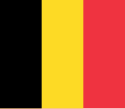 Belgium is a federal constitutional monarchy with a parliamentary system of governance. It is divided into three regions and three communities, that exist next to each other. Its two largest regions are the Dutch-speaking region of Flanders in the north and the French-speaking southern region of Wallonia. The Brussels-Capital Region, officially bilingual, is a mostly French-speaking enclave within the Flemish Region. A German-speaking Community exists in eastern Wallonia. Belgium’s linguistic diversity and related political conflicts are reflected in its political history and complex system of government. Belgium is a federal constitutional monarchy with a parliamentary system of governance. It is divided into three regions and three communities, that exist next to each other. Its two largest regions are the Dutch-speaking region of Flanders in the north and the French-speaking southern region of Wallonia. The Brussels-Capital Region, officially bilingual, is a mostly French-speaking enclave within the Flemish Region. A German-speaking Community exists in eastern Wallonia. Belgium’s linguistic diversity and related political conflicts are reflected in its political history and complex system of government.
 Historically, Belgium, the Netherlands and Luxembourg were known as the Low Countries; it once covered a somewhat larger area than the current Benelux group of states. The region was called Belgica in Latin, after the Roman province of Gallia Belgica. From the end of the Middle Ages until the 17th century, the area of Belgium was a prosperous and cosmopolitan centre of commerce and culture. From the 16th century until the Belgian Revolution in 1830, when Belgium seceded from the Netherlands, the area of Belgium served as the battleground between many European powers, causing it to be dubbed the “Battlefield of Europe,” a reputation strengthened by both world wars. Historically, Belgium, the Netherlands and Luxembourg were known as the Low Countries; it once covered a somewhat larger area than the current Benelux group of states. The region was called Belgica in Latin, after the Roman province of Gallia Belgica. From the end of the Middle Ages until the 17th century, the area of Belgium was a prosperous and cosmopolitan centre of commerce and culture. From the 16th century until the Belgian Revolution in 1830, when Belgium seceded from the Netherlands, the area of Belgium served as the battleground between many European powers, causing it to be dubbed the “Battlefield of Europe,” a reputation strengthened by both world wars.
Upon its independence, Belgium participated in the Industrial Revolution and, during the course of the 20th century, possessed a number of colonies in Africa. The second half of the 20th century was marked by rising tensions between the Dutch-speaking and the French-speaking citizens fueled by differences in language and the unequal economic development of Flanders and Wallonia. This continuing antagonism has led to several far-reaching reforms, resulting in a transition from a unitary to a federal arrangement during the period from 1970 to 1993. Despite the reforms, tensions between the groups remain; the formation of a coalition government took 18 months following the June 2010 federal election.
Belgium is a founding member of the European Union, Eurozone, NATO, OECD and WTO, and a part of the trilateral Benelux Union. Its capital, Brussels, hosts several of the EU’s official seats as well as the headquarters of many major international organizations such as NATO. Belgium is also a part of the Schengen Area.
Belgium is a developed country, with an advanced high-income economy and is categorized as “very high” in the Human Development Index.
|





 The Brussels International Exposition of 1935 (French: Exposition Universelle et Internationale Bruxelles de 1935) was a World’s fair held between 27 April and 6 November 1935 on the Heysel Plateau in Brussels (Belgium).
The Brussels International Exposition of 1935 (French: Exposition Universelle et Internationale Bruxelles de 1935) was a World’s fair held between 27 April and 6 November 1935 on the Heysel Plateau in Brussels (Belgium). .jpg/220px-Leopold_III_van_België_(1934).jpg) Leopold III (3 November 1901 – 25 September 1983) reigned as the fourth King of the Belgians from 1934 until 1951, when he abdicated in favour of the heir apparent, his son Baudouin. From 1944 until 1950, Leopold’s brother, Charles, served as prince regent while Leopold was declared unable to reign. Leopold’s controversial actions during the Second World War resulted in a political crisis known as the Royal Question. In 1950, the debate about whether Leopold could resume his royal functions escalated. Following a referendum, Leopold was allowed to return from exile to Belgium, but the continuing political instability pressured him to abdicate in 1951.
Leopold III (3 November 1901 – 25 September 1983) reigned as the fourth King of the Belgians from 1934 until 1951, when he abdicated in favour of the heir apparent, his son Baudouin. From 1944 until 1950, Leopold’s brother, Charles, served as prince regent while Leopold was declared unable to reign. Leopold’s controversial actions during the Second World War resulted in a political crisis known as the Royal Question. In 1950, the debate about whether Leopold could resume his royal functions escalated. Following a referendum, Leopold was allowed to return from exile to Belgium, but the continuing political instability pressured him to abdicate in 1951. Straddling the cultural boundary between Germanic and Latin Europe, Belgium is home to two main linguistic groups: the Dutch-speaking, mostly Flemish community, which constitutes about 59% of the population, and the French-speaking, mostly Walloon population, which comprises 41% of all Belgians. Additionally, there is a small group of German-speakers who live in the East Cantons located around the High Fens area, and bordering Germany.
Straddling the cultural boundary between Germanic and Latin Europe, Belgium is home to two main linguistic groups: the Dutch-speaking, mostly Flemish community, which constitutes about 59% of the population, and the French-speaking, mostly Walloon population, which comprises 41% of all Belgians. Additionally, there is a small group of German-speakers who live in the East Cantons located around the High Fens area, and bordering Germany. Belgium is a federal constitutional monarchy with a parliamentary system of governance. It is divided into three regions and three communities, that exist next to each other. Its two largest regions are the Dutch-speaking region of Flanders in the north and the French-speaking southern region of Wallonia. The Brussels-Capital Region, officially bilingual, is a mostly French-speaking enclave within the Flemish Region. A German-speaking Community exists in eastern Wallonia. Belgium’s linguistic diversity and related political conflicts are reflected in its political history and complex system of government.
Belgium is a federal constitutional monarchy with a parliamentary system of governance. It is divided into three regions and three communities, that exist next to each other. Its two largest regions are the Dutch-speaking region of Flanders in the north and the French-speaking southern region of Wallonia. The Brussels-Capital Region, officially bilingual, is a mostly French-speaking enclave within the Flemish Region. A German-speaking Community exists in eastern Wallonia. Belgium’s linguistic diversity and related political conflicts are reflected in its political history and complex system of government. Historically, Belgium, the Netherlands and Luxembourg were known as the Low Countries; it once covered a somewhat larger area than the current Benelux group of states. The region was called Belgica in Latin, after the Roman province of Gallia Belgica. From the end of the Middle Ages until the 17th century, the area of Belgium was a prosperous and cosmopolitan centre of commerce and culture. From the 16th century until the Belgian Revolution in 1830, when Belgium seceded from the Netherlands, the area of Belgium served as the battleground between many European powers, causing it to be dubbed the “Battlefield of Europe,” a reputation strengthened by both world wars.
Historically, Belgium, the Netherlands and Luxembourg were known as the Low Countries; it once covered a somewhat larger area than the current Benelux group of states. The region was called Belgica in Latin, after the Roman province of Gallia Belgica. From the end of the Middle Ages until the 17th century, the area of Belgium was a prosperous and cosmopolitan centre of commerce and culture. From the 16th century until the Belgian Revolution in 1830, when Belgium seceded from the Netherlands, the area of Belgium served as the battleground between many European powers, causing it to be dubbed the “Battlefield of Europe,” a reputation strengthened by both world wars.


